|
WRYBILL / Ngutu parore
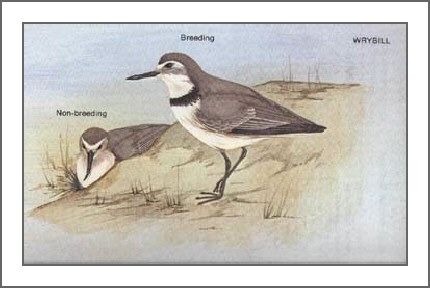
WRYBILL
Anarhynchus frontalis
FAMILY:
Charadridae Endemic
and fully protected. This little shore bird
is somewhat smaller than the Banded Dotterel. It
is a uniform light-grey above and white below, with
a black 'collar' during the breeding season. The
bill is black, long and pointed with the tip bent
to the right. Wrybills breed on South Island
broad shingle riverbeds east of the main divide in Canterbury
and North Otago. From December to July they
can be seen on mudflats and estuaries, with the majority
migrating to the Auckland area with small numbers elsewhere.
They feed on insects and small invertabrates.
Breeding is from September to November.
The nest is a small scrape in river sand
or shingle. The eggs, usually 2, are light-grey
evenly covered with minute dark spots.

PACIFIC GOLDEN PLOVER
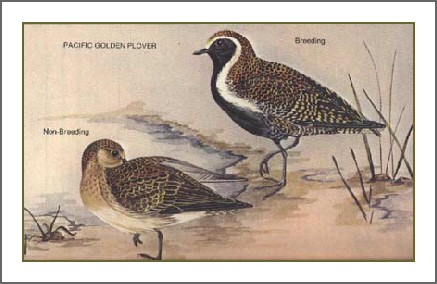
Pacific
Golden Plover Pluvialis dominica
FAMILY: Charadridae. Migrant,
from NE Siberia and West Alaska. There
are closely related sub-species in other parts of the
sub-arctic. Fully protected. Size
of a Blackbird, with a short bill. Non-breeding
plumage is from September to March and has no black
front and face or white stripe. Birds arrive
in NZ in September and
leave for the breeding grounds in Siberia and Alaska
by mid-April. The breeding plumage appears
in February. Immature birds retain this
plumage during the first year. Some non-breeders
stay in NZ during the breeding season. They
are found throughout NZ, especially Manukau, Firth of
Thames and Bluff. They are seen singly or
in small flocks on coastal mudflats, and inland on wet,
short pasture. They feed on worms, insects,
seeds and vegetable matter. Breeding, in
NE Siberia and Alaska, from May to June. The
eggs, 4, are yellowish-buff, strongly blotched with
blackish-brown.

NZ SHORE PLOVER / Tuturuatu
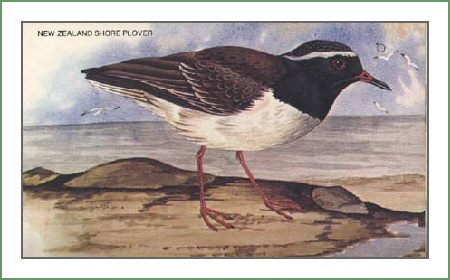
NZ Shore Plover Thinornis
novaeseelandiae FAMILY:
Charadriidae Endemic and fully
protected. Same size as Banded Dotterel.
The face on the male is black, brown in
the female.The immature bird is similar to the female
but has a smudgy face and black bill. These
birds are extremely rare although they were once plentiful
throughout NZ. They now breed only on South East Island
in the Chathams. Seen mainly on salt meadows
and rocky shore platforms. They feed on
invertabrates. Breeding is from September
to February. The nest is interwoven dried
roots and grass, in a crevise or hole among boulders
or vegetation, and mostly covered from above. The
eggs, 2-3, are olive-buff to pale brown with small dark
spots and blotches all over.

EASTERN BAR-TAILED GODWIT /
Kuaka
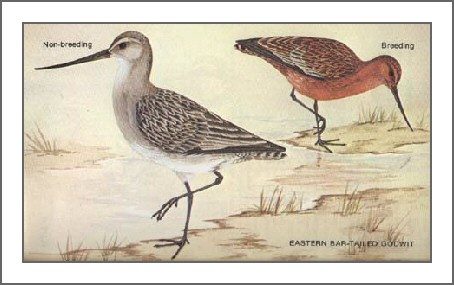
Eastern Bar-tailed Godwit Limosa
lapponica FAMILY: Scolopacidae
Migrant from NE Siberia and
Alaska. There is a closely related sub-species
in North Europe. Fully protected. Smaller
body than an Oystercatcher, with long black slender
legs and long, slightly upturned bill. Non-breeding
plumage is a mottled greyish-buff, from September to
February with the breeding plumage starting to appear
in February. Immature birds retain the non-breeding
plumage for the first year. Godwits arrive
in NZ in September and most depart in late March. Some
non-breeding birds remain here during the Winter. They
are found mostly in flocks on coastal marshes and mudflats
throughout NZ, with concentrations in Auckland, Farewell
Spit, Christchurch and Invercargill. They
feed mainly on crustacea, molluscs and marine invertabrates.
Breeding is in NE Siberia and Alaska from
May to June. The eggs, usually 4, are large,
greenish-brown with dark brown blotches.

WHITE HERON / Kotuku
ROYAL
SPOONBILL / Kotuku-ngutu-papa
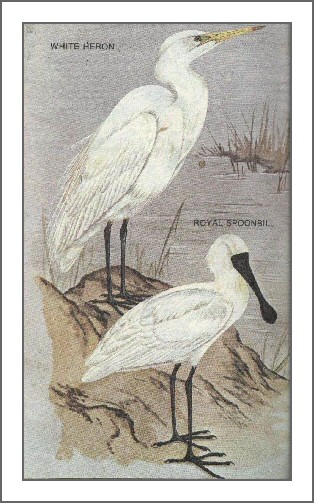
White
Heron Egretta alba FAMILY:
Ardeidae Native,
also found in Australia, with a closely related
sub-species throughout the world. Fully
protected. A large heron, pure white
with a yellow bill and black legs. The
adult bill turns black during the breeding season
and long white plumes appear on the back. They
fly with the long neck retracted, and a slow,
leisurely beat. Seen in small numbers
throughout the country but breeding only at
Okarito, South Westland in the company of Royal
Spoonbills. They disperse outside
the breeding season to lake edges, ponds, marshes
and estuaries. They feed on small
fish, insects, frogs, and sometimes small birds
using a quick stabbing motion of the bill.
Breeding is from September
to October. The nest is of twigs
in a colony on low trees and tree ferns near
the water. The eggs, 3-4, are pale
bluish-green.

Royal
Spoonbill Platelia regia
FAMILY:
Threskiornithidae
Native.
Self introduced since the 1850s
and also found in Australia and New Guinea.
Fully protected. Slightly
larger than the White Heron with the face,
large flattened bill and legs, black. The
rest of the plumage is white. The
neck is extended in flight, and the immature
birds may have a varying ammount of black on
the flight feathers visible when in flight.
Found throughout the country, they
are less common than the White Heron and only
breed in association with White Herons at Okarito.
They disperse to river estuaries
and lagoons outside the breeding season. They
feed on small crustacea in shallow water, by
sidesweeping the tip of the bill through the
water. Breeding is from November
to December and the nest is of sticks, in a
colony, on higher trees than the White Heron.
The eggs, 3-4, are white, sparingly
marked with brown blotches.

|
BANDED
DOTTEREL/ Tuturiwhatu
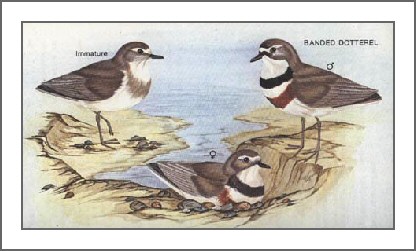
BANDED
DOTTEREL
Charadrius
bicinctus FAMILY: Charadriidae
Endemic
and fully protected. Similar size to Song
Thrush. Voice is a high pitched staccato 'pit pit'. Found
throughout NZ on coasts, riverbeds and lake shores.
After breeding there is a movement north
where there is a concentration in northern NZ in Winter.
Some winter over in Australia. Breeding
August to December, the nest being a scrape in sand
or shingle. Eggs, normally 3, are greyish
or brownish with dark brown or black spots and blotches
all over.

BLACK-FRONTED
DOTTEREL
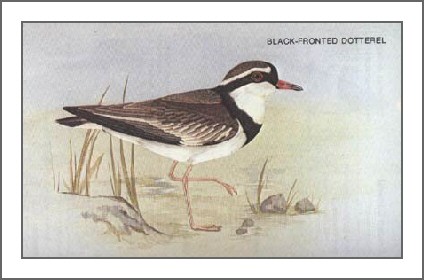
Black-fronted
Dotterel
Charadrius
melanops FAMILY: Charadridae
Native,
self introduced from Australia in the 1950s. Fully
protected. These birds are smaller than
the Banded Dotterel with a striking black and white
pattern on the head, and a broad V-shaped band on the
breast and chestnut-brown patch on the shoulder. The
black band is not present in the immature bird.
Their call is a high-pitched whistle or
a soft "Tink Tink". These birds
were first seen in Hawke's Bay and are now common in
Central Hawke's Bay shingle river beds, and spreading
to the Wairarapa, Manawatu and the east coast of the
South Island. In New Zealand they breed
on riverbeds that are not far inland. In
Australia they breed mainly on the edges of stagnant
water. Food consists of aquatic insects
and invertebrates. Breeding is from September
to January and the nest is usually a scrape among grass
and shingle or sometimes in the open. The
eggs, usually 3, are yellowish-stone, heavily spotted
and marked all over with dark brown.

TURNSTONE
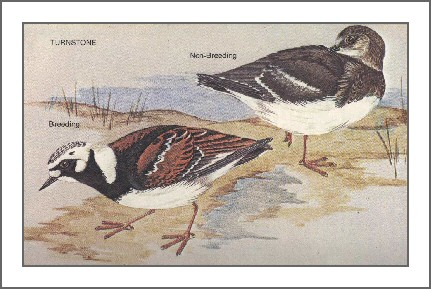
Turnstone
Arenaria interpres
FAMILY:
Scolopacidae
Migrant.
Circumpolar in the sub-arctic. The
birds seen in NZ are probably from Siberia and Alaska.
Fully protected. Slightly
larger than a Blackbird, these birds have orange legs
with a white lower back and wing bar which are prominent
when the bird is in flight. The non-breeding
plumage - October to January - is grey above and white
below. Breeding plumage - February till
their departure in April, is distinctively black, white
and rufous. They feed actively under stones
and flotsam. Turnstone start arriving in
September and most leave by mid-April. Small
flocks of immature birds remain in the North during
Winter. They are found throughout NZ on
shelly or stony foreshores feeding on crustacea and
insects. Breeding is in June in Siberia
and Alaska. The eggs, 4, are greyish-green
with irregular brown streaks, blotches and spots. This
bird is the third most numerous of the visiting waders.

KNOT /
Hauhou
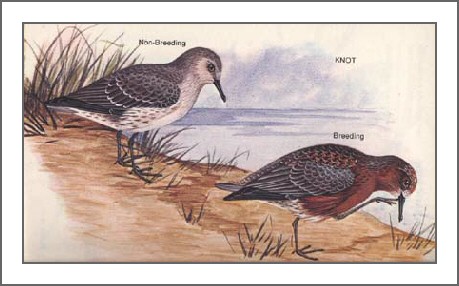
Knot Calidris
canutus FAMILY: Scolopacidae
Migrant from arctic regions
of Siberia and Alaska. Fully protected.
Same size as a Blackbird with the
non-breeding and immature plumage a nondescript grey
and white, September to February. The
breeding plumage is chestnut red below with chestnut
streaked grey above. They are generally
seen in tight flocks on sandy flats, often associated
with Godwits. Knots usually arrive
in NZ in September and most leave by mid-April. A
large number remain in NZ during the winter and these
flocks may contain both plumages. They
can be found throughout NZ coasts on inter-tidal mud,
sand flats and lagoons near the coast, especially Kaipara,
Firth of Thames, Manukau and Farewell Spit. They
feed on crustacea, molluscs and marine invertabrates.
Breeding is in June in Siberia and Alaska.
The eggs, 4, are greenish-buff with dark
spots.

WHITE-FACED HERON
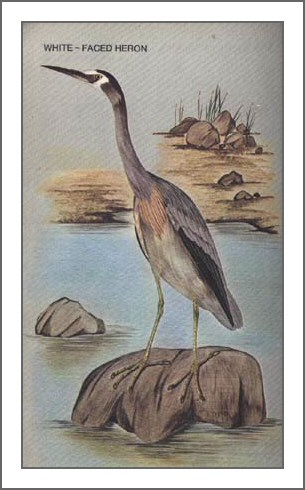
White
faced Heron Ardea
novaehollandiae FAMILY:
Ardeidae Native.
Self introduced from Australia and
rare until the 1940s. Fully protected.
Light blue-grey body with a white
face and pink blush to the breast. The
dark grey wing feathers contrast when in flight
with the paler body. The neck is
retracted when in flight, the wing beat being
slow and leisurely. The immature
bird has a less indistinct white face. This
is the most common of the herons and is widespread
throughout NZ. It can be seen in
all habitats except bush and rarely alpine.
Main habitats are ponds, lakes,
seashore, rivers and open pasture. They
often perch on trees and fence posts, and may
be seen in large groups. They feed
mainly on land and water insects like dragonflies,
blowflies, grasshoppers etc. and also fish,
frogs and small mammals. Breeding
is from August to December and the nest is a
small, untidy and flimsy structure of sticks,
found singly in high trees. (Not
colonial) The eggs, 3-5, are
light blue with white chalky marks.

REEF HERON
/ Matuku-moana
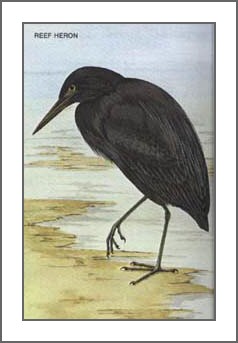
Reef
Heren Egretta sacra
FAMILY: Ardeidae
Native, also in Asia,
Australia and the SW Pacific. Fully
protected. A white form occurs throughout
the northern part of its range outside NZ. This
bird is similar to, but much darker than the
White-faced Heron, being a dark slate-blue all
over. The neck is retracted in flight
and the wing beat slow and leisurely. Seen
singly or in pairs. Reef Heron can
be seen throughout the country, but only on
sheltered, rocky coastlines. Sparingly
distributed. They are more common
in the northern half of the North Island and
larger off-shore islands, frequenting mudflats
and intertidal zones. They feed
close inshore on crabs and small fish. Breeding
is from September to February. The
nest of sticks is well hidden in shallow caves
or crevises, or among bushes on steep cliffs,
not far from water. The eggs, usually
3, are pale greenish-blue.

|

